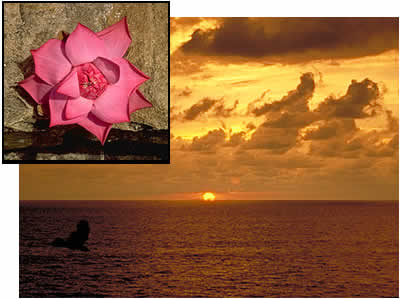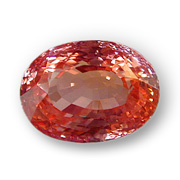|

By Richard
W. Hughes
Introduction/Name
Padparadscha
sapphire is a special variety of gem corundum, featuring a delicate
color that is a mixture of pink and orange – a marriage between
ruby and yellow sapphire. The question of just what qualifies for the
princely kiss of “padparadscha” is a matter of hot debate,
even among experts.
 Today,
padparadscha is narrowly defined by Western gemologists as a Sri
Lankan sapphire of delicate pinkish orange color. But the original
use of the term was somewhat different. Padparadscha is derived
from the Sanskrit/Singhalese padmaraga, a color akin to
the lotus flower (Nelumbo Nucifera ‘Speciosa’). Most
lotus blossoms are far more pink than orange, and in ancient times,
padmaraga was described as a subvariety of ruby (cf. the
Hindu Garuda Purana). Today, some define the gem's color
as a blend of lotus and sunset. Today,
padparadscha is narrowly defined by Western gemologists as a Sri
Lankan sapphire of delicate pinkish orange color. But the original
use of the term was somewhat different. Padparadscha is derived
from the Sanskrit/Singhalese padmaraga, a color akin to
the lotus flower (Nelumbo Nucifera ‘Speciosa’). Most
lotus blossoms are far more pink than orange, and in ancient times,
padmaraga was described as a subvariety of ruby (cf. the
Hindu Garuda Purana). Today, some define the gem's color
as a blend of lotus and sunset.
 |
|
The ideal color of a padparadscha has been described
by some as the marriage between a Sri Lankan lotus flower and a
sunset, each shown above (Author’s photos) |
|
 A
further complication is with orange sapphires from Tanzania’s
Umba Valley. While they are orange, their color tends to be much darker
than the ideal, with brownish overtones. Thus most traders do not feel
they qualify as true padparadschas. A
further complication is with orange sapphires from Tanzania’s
Umba Valley. While they are orange, their color tends to be much darker
than the ideal, with brownish overtones. Thus most traders do not feel
they qualify as true padparadschas.
Color
Unlike
other rubies and sapphires, the finest
color of padparadscha is not directly
a function of color intensity (saturation).
The most valuable padparadschas display
a delicate mixture of pink and orange,
similar to the crystal shown above.
Lighting
Sapphires
generally look best viewed with
fluorescent light or daylight (particularly
around
just after sunrise and before sunset).
Incandescent lights, whose output
is tilted towards the red end of
the spectrum,
do not do most blue sapphires justice.
Clarity
In
terms of clarity, padparadscha
sapphires tend to be cleaner than
ruby. Buyers
should look for stones which are
eye-clean, i.e., with no inclusions
visible to
the unaided eye. Because of the
pastel shades of most padparadschas,
any
inclusions will be quite visible.
Thus again,
the emphasis is on eye-clean stones.
Cut
In
the market, padparadschas are
found in a variety of shapes and
cutting
styles. Due to the shape of
the rough, stones are often cut with
overly
deep pavilions. Ovals and cushions
are the
most common, but rounds are
also
seen, as are other shapes,
such as the emerald
cut. Slight premiums are paid
for round stones. Cabochon-cut padparadschas
are not often seen (this cut
is
used for star stones, or those
not clean
enough to facet). The best
cabochons are reasonably transparent,
with
nice
smooth domes of good symmetry.
Prices
Padparadscha
is one of the world‘s
most expensive gems, with
prices similar
to those
fetched by fine ruby or emerald.
But like all gem materials,
low-quality (i.e., non-gem
quality) pieces
may
be available for a few dollars
per carat. Such stones are
generally not
clean enough to facet. Prices
for padparadschas vary greatly
according to size and
quality. At the top end,
they may reach as much as
US$30,000
per carat.
Stone Sizes
Padparadscha
sizes tend to be similar
to ruby. Probably the largest
fine stone
known is the
100.18-ct. oval in New
York’s
American Museum of Natural
History. But any fine untreated
padparadscha
of quality above two carats
is a rare stone. Fine untreated
padparadschas
above five carats can be
considered
world-class pieces.
Phenomena
While
star sapphires in other
colors are common, star
padparadschas
are practically
unknown. This is because
yellow and orange sapphires
from Sri
Lanka generally
lack the concentrations
of well-defined silk
necessary to produce
distinct
asterism.
 |
| Sri
Lankan padparadscha sapphire crystal, 8 by 5 cm; Collection: Paul Ruppenthal Photo: Studio Hartmann from Gem & Crystal
Treasures by Peter Bancroft |
|
Sources
The
original locality for padparadscha is Sri Lanka (Ceylon) and many purists
today believe the term should be restricted only to stones from Ceylon.
However, fine stones have also been found in Vietnam’s Quy Chau
district, Tanzania’s Tunduru district, and Madagascar. Stones
from these latter three areas are often heat-treated and may reach
rich “orange-juice” or “papaya” oranges that are
quite beautiful.
 Tanzania’s
Umba Valley also produces orange sapphires
and some dealers argue that these qualify
as padparadschas. However, their color
tends to be much darker than the ideal,
with brownish overtones. Thus most traders
do not feel they qualify as true padparadschas. Tanzania’s
Umba Valley also produces orange sapphires
and some dealers argue that these qualify
as padparadschas. However, their color
tends to be much darker than the ideal,
with brownish overtones. Thus most traders
do not feel they qualify as true padparadschas.
Enhancements
Today,
many padparadscha sapphires are heat-treated
to improve their appearance. The
resulting stones are completely stable
in color.
In lower qualities, heat treated
stones sell for roughly the same as
untreated
stones of the same quality. However,
for finer qualities, untreated stones
fetch a premium that is sometimes
50% or more when compared with treated
stones of similar quality.
A fraudulent treatment sometimes
seen is where a pink stone is irradiated
to give it a padparadscha color. The resulting color is unstable and
will fade with prolonged exposure to sunlight. Other treatments, such
as oiling, dying and surface diffusion are seen on occasion.
 Beginning
in late 2001, sapphires of padparadscha
colors began appearing from the ovens
of Thai burners. It was later found
that these gems owe their color to
a form of outside-in bulk (‘surface’)
diffusion. See
this link for more on these stones. Beginning
in late 2001, sapphires of padparadscha
colors began appearing from the ovens
of Thai burners. It was later found
that these gems owe their color to
a form of outside-in bulk (‘surface’)
diffusion. See
this link for more on these stones.
 As
with all precious stones, it is a
good practice to have any major purchases
tested by a reputable gem lab, such
as the GIA or AGTA,
to determine if a gem is enhanced. As
with all precious stones, it is a
good practice to have any major purchases
tested by a reputable gem lab, such
as the GIA or AGTA,
to determine if a gem is enhanced.
Imitations
Synthetic
padparadscha sapphires have been
produced by the Verneuil process
since about
1908 and cost just pennies per
carat. They have also been produced
by the
flux, hydrothermal, floating zone
and Czochralski processes, but
such stones
are rarely encountered. Doublets
consisting of natural sapphire
crowns and synthetic
sapphire pavilions are sometimes
seen, particularly in mining areas.
Synthetics
are also common at the mines, in
both rough and cut forms.
 |
| The
above stone is a fine example of a padparadscha sapphire. It features
the delicate pinkish orange color that resembles the color of a
lotus flower. Photo: Wimon Manorotkul; Gem: Pala International |
|
Properties
of Padparadscha Sapphire
| |
Padparadscha
Sapphire (a variety of corundum) |
| Composition |
Al2O3 |
| Hardness
(Mohs) |
9 |
| Specific
Gravity |
4.00 |
| Refractive
Index |
1.762–1.770
(0.008) Uniaxial negative |
| Crystal
System |
Hexagonal
(trigonal) |
| Colors |
Mixture
of pink and orange |
| Pleochroism |
Weakly
dichroic: two shades of the body color |
| Phenomena |
None |
| Handling |
Generally
no special care needed; all ruby and sapphire jewelry can be cleaned
using hot soapy water, or detergent. Make sure to rinse thoroughly
afterwards as detergents can cause dermatitis and allergic reactions.
Enzyme cleaners should be avoided for the same reasons. Brushing
with an old tooth brush to remove dirt and grease will also help.
Cleaning agents containing chlorine may have a detrimental effect
on low-carat gold alloys, so are best avoided |
| Enhancements |
Frequently
heated; occasionally irradiation, oiling, dying, surface diffusion |
| Synthetic
available? |
Yes |
Further Reading
The Collector Gem Buying Guides
In addition to the above, please visit the Learning
Vault at Palagems.com for many additional articles on gems, minerals and mining.
|




